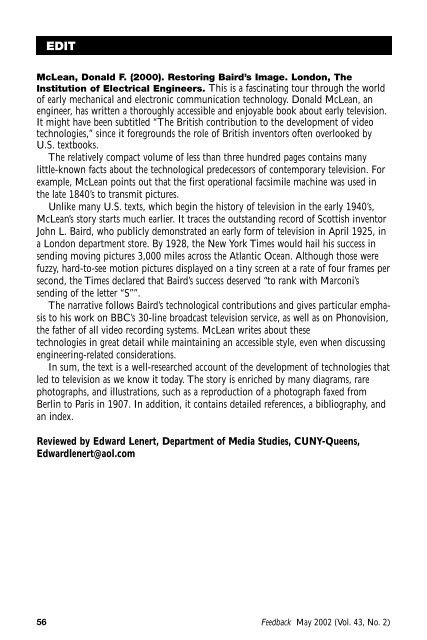Feedback May 2002 (Vol 43 No 2)
Feedback May 2002 (Vol. 43, No. 2) - Broadcast Education ...
Feedback May 2002 (Vol. 43, No. 2) - Broadcast Education ...
- No tags were found...
You also want an ePaper? Increase the reach of your titles
YUMPU automatically turns print PDFs into web optimized ePapers that Google loves.
EDITMcLean, Donald F. (2000). Restoring Baird’s Image. London, TheInstitution of Electrical Engineers. This is a fascinating tour through the worldof early mechanical and electronic communication technology. Donald McLean, anengineer, has written a thoroughly accessible and enjoyable book about early television.It might have been subtitled “The British contribution to the development of videotechnologies,” since it foregrounds the role of British inventors often overlooked byU.S. textbooks.The relatively compact volume of less than three hundred pages contains manylittle-known facts about the technological predecessors of contemporary television. Forexample, McLean points out that the first operational facsimile machine was used inthe late 1840’s to transmit pictures.Unlike many U.S. texts, which begin the history of television in the early 1940’s,McLean’s story starts much earlier. It traces the outstanding record of Scottish inventorJohn L. Baird, who publicly demonstrated an early form of television in April 1925, ina London department store. By 1928, the New York Times would hail his success insending moving pictures 3,000 miles across the Atlantic Ocean. Although those werefuzzy, hard-to-see motion pictures displayed on a tiny screen at a rate of four frames persecond, the Times declared that Baird’s success deserved “to rank with Marconi’ssending of the letter “S””.The narrative follows Baird’s technological contributions and gives particular emphasisto his work on BBC’s 30-line broadcast television service, as well as on Phonovision,the father of all video recording systems. McLean writes about thesetechnologies in great detail while maintaining an accessible style, even when discussingengineering-related considerations.In sum, the text is a well-researched account of the development of technologies thatled to television as we know it today. The story is enriched by many diagrams, rarephotographs, and illustrations, such as a reproduction of a photograph faxed fromBerlin to Paris in 1907. In addition, it contains detailed references, a bibliography, andan index.Reviewed by Edward Lenert, Department of Media Studies, CUNY-Queens,Edwardlenert@aol.com56<strong>Feedback</strong> <strong>May</strong> <strong>2002</strong> (<strong>Vol</strong>. <strong>43</strong>, <strong>No</strong>. 2)
















